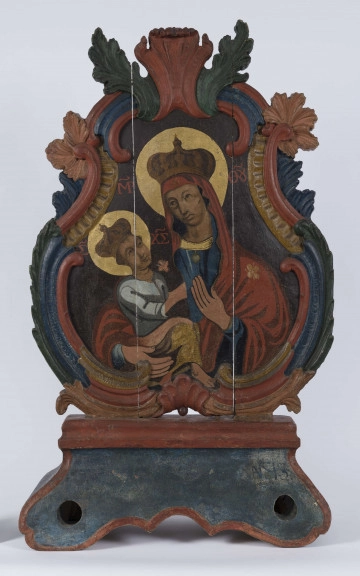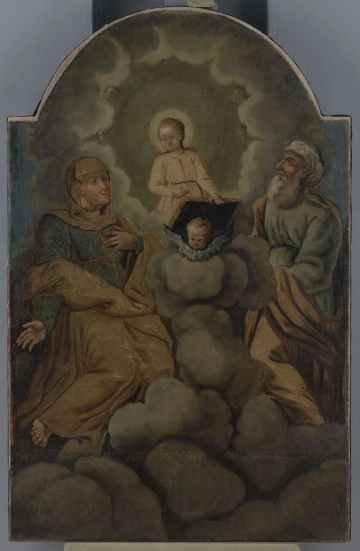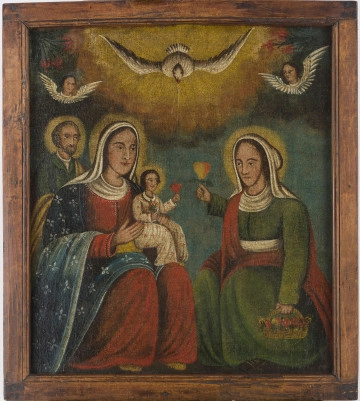
Our Lady of Chełm and Saint Nicholas
1801 — 1900
National Museum in Lublin
Part of the collection: Folk Art of the Lublin Region (17th–1st half of the 20th c.)
The figure of the Virgin Mary is the most common representation in Christian art, appearing since the 3rd century. Initially Mary appeared in scenes related to Jesus, but after the Council of Ephesus in 431 there was an increase in her worship, thus more independent representations appeared. Over time, Marian cycles also began to appear in the form of scenes from Mary's life based on the gospels and apocrypha; including: Mary's birth, Mary's teaching, Mary's entry into the temple of Jerusalem, the nuptials, the Annunciation, the Visitation, the Nativity, the Pietà, the Dormition, the Assumption, and the Coronation.
The crown has been an attribute of Mary, Queen of Heaven, since the very first depictions. The coronation scene, in which the Virgin Mary is crowned by Christ or the Holy Trinity (see E/5971/ML), has been in art since the 13th century. In the Middle Ages, it was considered the most important subject of Marian glorification depictions. Originally Mary thronged beside her son and humbly bowed her head towards him. Since the 14th century she kneels before Jesus. In this way her role as the advocate of humanity was emphasised. In later times she was depicted frontally on a throne made of clouds, between the Son of God on her right and God the Father on her left, who crown her together. Above the crown floated the dove of the Holy Spirit. From the late Middle Ages onwards, the depiction of Mary's crowning was sometimes combined with her assumption into heaven. In Baroque art the scene of the Assumption overshadowed the coronation scene and became the foreground representation. The paintings then depicted Mary ascending to heaven, with the Holy Trinity and angels holding the crown waiting for her in the heavenly sphere.
However, the theme of the crowning of the Virgin Mary had painterly enthusiasts. For example, the Spanish painter of Greek origin Dominikos Theotokopulos, known as El Greco, created four commissioned versions of the scene. It was also painted by non-professional painters, and their representations had an equally strong emotional and symbolic message, which can be judged, among other things, by the colour of the figures' robes, which indicated in turn: the red purple of Christ - martyrdom, the blue of Mary - eternity, the gold of God the Father - divinity.
Author / creator
Dimensions
cały obiekt: height: 48 cm, width: 67 cm
Object type
picture
Technique
oil technique
Material
canvas, oil-based paint
Creation time / dating
Creation / finding place
Owner
The National Museum in Lublin
Identification number
Location / status

unknown
1801 — 1900
National Museum in Lublin

unknown
1801 — 1900
National Museum in Lublin

unknown
1845 — 1855
National Museum in Lublin
DISCOVER this TOPIC
National Museum in Szczecin
DISCOVER this PATH
Educational path
0/500

We use cookies to make it easier for you to use our website and for statistical purposes. You can manage cookies by changing the settings of your web browser. More information in the Privacy Policy.
We use cookies to make it easier for you to use our website and for statistical purposes. You can manage cookies by changing the settings of your web browser. More information in the Privacy Policy.
Manage cookies:
This type of cookies is necessary for the website to function. You can change your browser settings to block them, but then the website will not work properly.
WYMAGANE
They are used to measure user engagement and generate statistics about the website to better understand how it is used. If you block this type of cookies, we will not be able to collect information about the use of the website and we will not be able to monitor its performance.